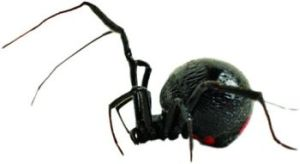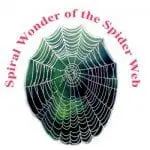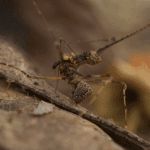Living creatures have a wide variety of ingenious ways of sticking to things, (1) which we have written about in this magazine. These include: the fine hairs on gecko (2) and spider (3) feet that exploit fine chemical forces, and have inspired self-cleaning adhesive tape, (4) the mechanical and hydraulic machinery of ant and bee feet (5) and mussels that secrete special proteins that can even stick to “non-stick” frying pans. (6)
One of the best-known sticky things in nature is the spider’s web. We have written before on the amazing strength of the fibres—they are stronger than any man-made fibre of the same thickness, including Kevlar and steel, (7) and are heat resistant as well. (8) However, strength is not enough to trap insects—spiders also deposit tiny droplets of glue over the fibres, about 20 per mm of length. How this worked was a mystery—until biologists at the University of Akron, Ohio, USA, discovered its secret. (9)
Most glue is uni-functional: its one function is to stick things together. But the spider glue is multi-functional—a ‘smart material’.
Most glue is uni-functional: its one function is to stick things together. But the spider glue is multi-functional—a ‘smart material’. (10) It is composed of polymers—long molecules composed of small molecules joined together—called glycoproteins, where the small molecules are amino acids and sugars. These are cross-linked, which means that forces can be transmitted efficiently—as one of the researchers said, “The success of an adhesive, however, depends on how efficiently the force is transmitted through the adhesive.” (11) The crosslinking makes the droplets a hundred times stickier.
But this might be a problem when the spider wants to remove a trapped insect from the web. The solution is a variable-strength glue: much stronger at high speeds than at low speeds. Thus it can stick strongly to a flying insect, but when the insect struggles, with slower movements than flight, then the glue behaves more like a rubber band. When the insect stops moving, the spider can remove it fairly easily because the sticky force is lower still.
As usual, the researchers pay a fact-free homage to evolution, although it was irrelevant to their research. Take out such vacuous nonsense, and the researchers’ comments provide powerful evidence for design:

“Nature has evolved a myriad of well-designed adhesives that assist in locomotion, self-defense and prey capture”. Then they list some examples in the first paragraphs. (9)
“Existence of similar adhesion strategies in distantly related species of animals suggests a common design principle in the evolution of natural adhesives.” (11)
To highlight the reality of design, human designers are now trying to learn from the spider’s secrets. One researcher said:
“This finding should significantly benefit the development of synthetic adhesives for biomedical, orthopedics and wound-healing applications. The understanding of how spiders use this unique glue will allow scientists to develop reversible adhesives that work in the presence of water.” (11)
This is hardly the only example of humans learning from the Master Designer (12) —in reality, “Nothing in biology makes sense except in the light of design.” (13)
The only remaining question is, why would God create something used to entangle insects? First, this is irrelevant to the fact of design. Second, maybe they originally entangled something else before the Fall. Even today, some baby spiders catch pollen for food, (14) and there is even a vegetarian spider. (15) Third, insects are likely not biblical life (Hebrew nephesh chayyah), since they were not Ark passengers—the Flood was to wipe out land creatures that breathed through nostrils (Genesis 7:22).
References and notes
1. See Sarfati, J., By Design, chapter 7, CBP, 2008.
2. Great gecko glue? Creation 23(1):54–55, 2000.
3. Spectacular spider stickiness, Creation 27(4):54–55, 2005.
4. Gecko foot design—could it lead to a real ‘spiderman’? Creation 26(1):22–23, 2003.
5. Startling stickiness, Creation 24(2):37, 2002.
6. Mussel muscle, Creation 22(4):7, 2000.
7. God’s webspinners give chemists free lessons, Creation 23(2):20–21, 2001.
8. Hot spider silk, Creation 27(3):9, 2005.
9. Sahni, V., Blackledge, T.A., and Dhinojwala, A., Viscoelastic solids explain spider web stickiness, Nature Communications 1(19):1–4, 17 May 2010 | doi:10.1038/ncomms1019.
10. Lee, H., Biomaterials: Intelligent glue, Nature 465:298-299, 19 May 2010 | doi:10.1038/465298a.
11. Researchers discover spider webs’ true ‘sticking power’, physorg.com, 17 May 2010.
12. See Expert engineer eschews “evolutionary design”: Philip Bell interviews creationist and Professor of Engineering Design, Stuart Burgess, Creation 32(1): 35–37, 2010; creation.com/biomimetics.
13. Turning around the cliché from famous evolutionist Theodosius Dobzhansky (1900–1975), by substituting ‘design’ where he had ‘evolution’.
14. Pollen-eating spiders, Creation 22(3):5, 2000; White, T., Pollen-eating spiders, Nature Australia 26(7):5, Summer 1999–2000.
15. Catchpoole, D., Vegetarian spider, Creation 31(4):46, 2009.
Feature Image Compilation: ©istockphoto.com/ExcellentPhoto; Emily Hilverts






